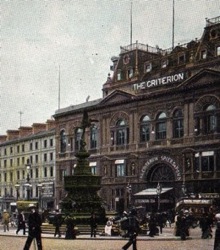An outrageous incident disrupts a London seance with the leading medium of the day. Florence Cook, a beautiful 17-year old tradesman’s daughter from North London claimed to inhabit the spirit of “Katie,” daughter of Morgan, the legendary pirate “King.” Her invitation-only séances were not to be missed. Gentlemen must bring trinkets to entice “Katie” to appear.
On this evening, with Florence safely locked in her cabinet, the spectral form of “Katie” manifested herself in the dark room. Suddenly, in violation of all the rules, Herr Volckman leapt from his seat to tackle the “spirit.” There was a wild struggle, Volckman was subdued, and Katie collapsed to the floor. The room was cleared and when the lights came back on, Katie was gone, and Florence was there, appearing unwell. Volckman’s treachery was inexcusable but he announced that it was no ghost he felt in his arms. Florence/Katie’s reputation was badly shaken by what one occult paper called a “Gross Outrage at a Spirit Circle.”
Enter William Crookes. He was 41, married, and a self-taught chemist who had discovered thallium and was a fellow of the Royal Academy of Science. After his brother was lost at sea, Crookes turned his interest to the spirit world. Given his credentials, Crookes was soon established as the “investigator.” He agreed to determine, once and for all, if Florence and Katie were one and the same person. To better isolate his subject, he took Florence home with to his laboratory on Mornington Road. She remained there six months.
Through the magic of his newly invented "spirit lamp," containing phosphorised oil, Crookes claimed he was able measure and photograph both Florence and a co-operative “Katie.” He declared that Florence and her pirate friend were indeed separate beings, different in height, complexion and hair color. The Spiritualist, the leading publication for true-believers, hailed the news, saying Crookes had “placed beyond all question” the authenticity of Florence’s powers.
By far, however, the Crookes report was met with bemusement in the secular world, and vicious hostility from the scientific. Adding to the public’s general merriment and the scientific derision was Crookes detailed accounts of his “physical” contact with "Katie." He recalled one moment: Feeling, however, that if I had not a spirit, I had at all events a lady close to me, I asked her permission to clasp her in my arms … Permission was graciously given and I accordingly did – well, what any gentleman would do under the circumstances.
While a modern researcher might well call Crookes methodology “highly eroticised but unfailingly respectable,” his contemporaries were less forgiving. Enemies suggested that the scientist had been seduced by his attractive houseguest, while his wife was confined to bed expecting the couple’s tenth child. So many rumors circulated that Crookes finally issued a statement: “My good and true wife knows everything about this and quite approves of my conduct.”
Florence Cook's powers soon faded. Crookes and his wife lived to celebrate their 50th wedding anniversary. He was knighted in 1897. In 1907, there were word of the Nobel Prize for Chemistry; but he never got it. He never retracted any of his spiritualist writings. He died in 1919 having worked well into his 70’s, developing fertilizers, new sewage disposal schemes and inventing the “Crookes lens” for eyeglasses. All of this, surely, more in the physical, than the psychical, realm.
Photograph at phantasmpsiresearch.com






























